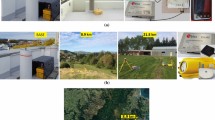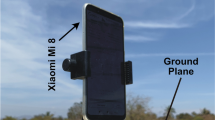Abstract
The global navigation satellite system (GNSS) measurements to determine ionospheric total electron content (TEC) are mainly derived from expensive geodetic-grade receivers, which are not conducive to high-density placement. In this work, we present an analysis of the performance of ionospheric TEC determined by GNSS dual-frequency measurements derived from the smartphone, taking the Xiaomi 8 (XMI8) as an example. First, the ionospheric observable is retrieved from the code and carrier phase data using the carrier-to-code leveling technique and a new carrier-to-noise weighting strategy instead of an elevation weighting strategy, considering the characteristic of the GNSS measurements from smartphones. Then, the absolute ionospheric slant TEC (STEC) values are isolated from the ionospheric observables by modeling with the generalized trigonometric series function. The experimental data, covering over 120 h, were taken from two situations: one is the data collected by the original smartphone antenna; the other is the external geodetic-grade antenna. The TEC data obtained from the collocated geodetic-grade receiver are used as reference data to evaluate the performance of the TEC values from XMI8. Compared to the reference data, the evaluation results show that the ionospheric STEC extraction accuracy can reach total electron content unit (TECU) values of 0.17 and 0.11 under the two different situations in the continuous carrier phase satellite arc without cycle slips. In addition, the VTEC modeling accuracy is above 5 and 2 TECU in the two different situations, respectively. Thus, we concluded that consumer-level GNSS chipsets are highly potential in the future to increase the ionospheric monitoring station density due to their low costs and good data quality.











Similar content being viewed by others
Data availability
The GNSS observational data can be made available upon request by contacting the author.
References
Amiri-Simkooei AR, Asgari J (2011) Harmonic analysis of total electron contents time series: methodology and results. GPS Solut 16:77–88. https://doi.org/10.1007/s10291-011-0208-x
Benvenuto L, Dabove P, Ferrando I, Sguerso D (2021) Preliminary results on tropospheric ZTD estimation by smartphone. Remote Sens 13(22):4567. https://doi.org/10.3390/rs13224567
Brunini C, Azpilicueta FJ (2009) Accuracy assessment of the GPS-based slant total electron content. J Geod 83:773–785. https://doi.org/10.1007/s00190-008-0296-8
Bruno J, Darugna F, Bolmgren K, Wübbena J, Mitchell C, Schmitz M (2020) Quality analysis of dual-frequency smartphone-based ionospheric TEC measurements: what can be achieved? Ann Geophys 64:1. https://doi.org/10.4401/ag-8517
Ciraolo L, Azpilicueta F, Brunini C, Meza A, Radicella SM (2007) Calibration errors on experimental slant total electron content (TEC) determined with GPS. J Geod 81:111–120. https://doi.org/10.1007/s00190-006-0093-1
Fortunato M, Ravanelli M, Mazzoni A (2019) Real-time geophysical applications with android GNSS raw measurements. Remote Sens 11(18):2113. https://doi.org/10.3390/rs11182113
Geng J, Li G (2019) On the feasibility of resolving android GNSS carrier-phase ambiguities. J Geodesy 93:2621–2635. https://doi.org/10.1007/s00190-019-01323-0
Georgiadiou Y (1994) Modeling the ionosphere for an active control network of GPS stations. LGR-Series-Publications of the Delft Geodetic Computing Centre 7(1).
GmbH G (2020) Geo++ RINEX Logger, 2.1.6 edn.
Hatch R (1982) The synergism of GPS code and carrier measurements. In: Proceedings of the third international symposium on satellite Doppler positioning at physical sciences laboratory of New Mexico State University, Feb. 8–12, vol 2, pp 1213–1231
Hernández-Pajares M, Juan JM, Sanz J (1999) New approaches in global ionospheric determination using ground GPS data. J Atmos Sol Terr Phys 61:1237–1247. https://doi.org/10.1016/S1364-6826(99)00054-1
Hernández-Pajares M, Roma-Dollase D, Krankowski A, García-Rigo A, Orús-Pérez R (2017) Methodology and consistency of slant and vertical assessments for ionospheric electron content models. J Geod 91:1405–1414. https://doi.org/10.1007/s00190-017-1032-z
Kuusniemi H, Wieser A, Lachapelle G, Takala J (2007) User-level reliability monitoring in urban personal satellite-navigation. IEEE Trans Aerosp Electron Syst 43:1305–1318. https://doi.org/10.1109/TAES.2007.4441741
Liu W, Shi X, Zhu F, Tao X, Wang F (2019) Quality analysis of multi-GNSS raw observations and a velocity-aided positioning approach based on smartphones. Adv Space Res 63:2358–2377. https://doi.org/10.1016/j.asr.2019.01.004
Massarweh L, Fortunato M, Gioia C (2020) Assessment of real-time multipath detection with android raw GNSS measurements by using a Xiaomi Mi 8 smartphone. In: 2020 IEEE/ION Position, Location and Navigation Symposium (PLANS), Portland, OR, USA, April 20–23, pp 1111–1122. https://doi.org/10.1109/PLANS46316.2020.9110169
Paziewski J (2020) Recent advances and perspectives for positioning and applications with smartphone GNSS observations. Meas Sci Technol 31:091001. https://doi.org/10.1088/1361-6501/ab8a7d
Paziewski J, Sieradzki R, Baryla R (2019) Signal characterization and assessment of code GNSS positioning with low-power consumption smartphones. GPS Solut 23:98. https://doi.org/10.1007/s10291-019-0892-5
Schaer S (1999) Mapping and predicting the Earth's ionosphere using the Global Positioning System. Geod-Geophys Arb Schweiz 59.
Teunissen P, Montenbruck O (2017) Springer handbook of global navigation satellite systems. Springer, Cham
Yang Y, Mao Y, Sun B (2020) Basic performance and future developments of BeiDou global navigation satellite system. Satell Navig 1:1. https://doi.org/10.1186/s43020-019-0006-0
Yuan Y, Ou J (2004) A generalized trigonometric series function model for determining ionospheric delay. Prog Nat Sci 14:1010–1014. https://doi.org/10.1080/10020070412331344711
Yuan Y, Mi X, Zhang B (2020) Initial assessment of single- and dual-frequency BDS-3 RTK positioning. Satell Navig 1:31. https://doi.org/10.1186/s43020-020-00031-x
Zangenehnejad F, Gao Y (2021) GNSS smartphones positioning: advances, challenges, opportunities, and future perspectives. Satell Navig 2:24. https://doi.org/10.1186/s43020-021-00054-y
Zhang B, Teunissen PJG, Yuan Y, Zhang H, Li M (2017) Joint estimation of vertical total electron content (VTEC) and satellite differential code biases (SDCBs) using low-cost receivers. J Geod 92:401–413. https://doi.org/10.1007/s00190-017-1071-5
Zhang X, Tao X, Zhu F, Shi X, Wang F (2018) Quality assessment of GNSS observations from an Android N smartphone and positioning performance analysis using time-differenced filtering approach. GPS Solut 22:70. https://doi.org/10.1007/s10291-018-0736-8
Zhang X, Zhang B, Yuan Y, Zha J (2020) Extending multipath hemispherical model to account for time-varying receiver code biases. Adv Space Res 65:650–662. https://doi.org/10.1016/j.asr.2019.11.003
Zhao C, Yuan Y, Zhang B, Li M (2019) Ionosphere sensing with a low-cost, single-frequency, multi-GNSS receiver. IEEE Trans Geosci Remote Sens 57:881–892. https://doi.org/10.1109/tgrs.2018.2862623
Acknowledgements
This work was partially funded by the Hubei Provincial Natural Science Foundation of China (Grant No. 2020CFA048) and the National Natural Science Foundation of China (Grant No. 42022025). Baocheng Zhang is supported by the CAS Pio-neer Hundred Talents Program. Many thanks go to the Geo++ GmbH for providing Geo++ RINEX Logger APP.
Author information
Authors and Affiliations
Corresponding author
Additional information
Publisher's Note
Springer Nature remains neutral with regard to jurisdictional claims in published maps and institutional affiliations.
Rights and permissions
Springer Nature or its licensor holds exclusive rights to this article under a publishing agreement with the author(s) or other rightsholder(s); author self-archiving of the accepted manuscript version of this article is solely governed by the terms of such publishing agreement and applicable law.
About this article
Cite this article
Xu, L., Zha, J., Li, M. et al. Estimation of ionospheric total electron content using GNSS observations derived from a smartphone. GPS Solut 26, 138 (2022). https://doi.org/10.1007/s10291-022-01329-w
Received:
Accepted:
Published:
DOI: https://doi.org/10.1007/s10291-022-01329-w




